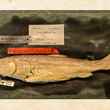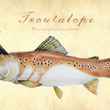Charlie Bush loves speckled trout.
The “L” word often gets tossed around with flippancy, but this is not one of those instances and it’s not hyperbole, and it goes beyond catching and eating speckled trout. No, it doesn’t. Charlie’s love for speckled trout is the purest manifestation of a predator/prey relationship.
It’s actually Captain Charlie Bush. Charlie is a licensed Louisiana charter captain, as well as host and guide for the first days of my Louisiana trip. His solid handshake and offer of a beer right as I stepped from the car confirmed the opinion I’d formed after a few phone conversations: We were going to get along fantastically even though he sounded like a Yankee.
I found out about Charlie’s love during my recovery from a food coma brought on by buckets of shrimp bisque and heaps of bread, shrimp, and speckled trout fillets prepared by Charlie’s wife Jerri. I think there were some vegetables on the table, too, but the bisque, shrimp and speckled trout are what did me in. The revelation about Charlie came about as many revelations do — by accident.
Charlie’s son-in-law Lynn let it slip as Charlie and I were discussing the next morning’s red drum fishing trip. Red drum are the sexy all-stars in Louisiana marsh fishing. Indeed, I’d brought a specific rod, reel and line combo with reds in mind, and Charlie knew this. But Lynn did not.
As the conversation slipped into fishing, I noticed that almost all of Charlie’s fishing tales were about speckled trout. I’d steer us into redfish and charlie would steer us back to specks. Finally, as I started asking about flies and hooksets for the bull reds finning through my head, Lynn piped up. “Charlie, why you going for redfish tomorrow? You don’t even like redfish.”
The silence was palpable as Charlie’s mouth slowly formed a sheepish grin, and he tried to delicately walk the comment right back into Lynn’s mouth. “Well, now, it’s not that I don’t like redfish, it’s just that…” Unsuccessful in his attempted redaction, Charlie sat in silence. Grinning.
So I prodded. “You don’t like redfish, Charlie?” And then it all came gushing out.
“Redfish are easy. I don’t mean easy, but redfish grab a bait and there’s no doubt they want it,” said Charlie as he thumped my arm with an open palm then grabbed it with a shocking ferocity. “And then you set the hook, and, sure, they pull hard. But trout are different. Trout make you earn it.” And with that statement, he gave my forearm a gentle, barely perceptible pinch. “That’s a trout bite. If you’re not paying attention, you’ll miss it.”
Charlie talked about speckled trout, the Louisiana marsh, and how both were in danger as we sipped beer and I nodded in sober understanding. We could have talked all night, but mornings come early when you want to be on the water at daybreak and the water is a 45-minute drive away.
The drive offered more chance for conversation, though, I had to wait for Charlie’s morning ritual. “Just give me 10 minutes and I’m yours for the rest of the day,” said Charlie as he slipped a CD into the player and turned the volume knob. Words of prayer came through the speakers in a calm baritone. It was a Catholic Rosary. I’m not of any religious affiliation, and coming from Assembly of God land, I’d never heard a rosary before. But the hushed reverence and sense of humility was moving. There was a presence of something larger than ourselves in the truck. It was reassuring to think that at least one of us thought a higher power was in charge.
Speckled trout is the colloquial name for spotted seatrout, which is not a trout at all but variety of weakfish and weakfish are in the drum family. So speckled trout and red drum are related despite their personality differences. You may think of redfish when you think of marsh fishing, but most Louisiana folks think of specks. Speckled trout are the lynchpin securing culture and economy. Also, they are damn fine eating.

Charlie’s intimacy with the specks comes from a lifetime of catching, eating and now tagging the fish. He tagged over 2,000 speckled trout last year alone — more fish than anyone else by a wide margin — as a participant in the highly successful but now puzzlingly defunct, or at least scheduled for death, Tag Louisiana program. The program was a joint effort with the Louisiana Department of Wildlife and Fisheries and the Coastal Conservation Association. But the backbone of the program was volunteer anglers like Charlie who took the time and effort to record information about and tag caught specks, redfish, and red snapper in a timely manner to ensure the tagged fish survives to hopefully be caught again. Basically, they did legwork for fisheries biologists that laid a foundation for understanding the travel patterns of coastal Louisiana’s bread and butter fish. Why the program was cut is still a mystery and likely mired so deep in the muck of politics and bureaucratic bullshit that we’ll never know the real why. To my mind, it’s one of the finest examples of citizen scientists keeping tabs on an incredible fishery. We need more of these programs, not less.
As this excerpt from a 2006 study by Louisiana State University illustrates, speckled trout are the staple of coastal Louisiana’s mind-boggling fisheries and a culture in which everyone fishes and eats fish.
Recreational fishing generated $82 billion in sales, $24 billion in income and supported 534,000 jobs in 2006… In 1997, Louisiana anglers harvested 6.7 million spotted seatrout while in 2006, more than 24 million were caught (13 million of which were harvested and more than 10 million released). In the Gulf of Mexico region, the recreational catch of spotted seatrout is the most caught species with more 36 million fish caught in 2006. Louisiana accounted for 24 million of these fish or 66 percent. Also, the number of anglers in Louisiana increased by 63 percent between 1997 (616,000) and 2006 (1.2 million anglers). Certainly this is an indication of the economic importance of the spotted seatrout to Louisiana.
These disappearing marshes discussed in the first installment of Vanishing Paradise serve as spawning water for specks where the males sing with that peculiar croaking/drumming that gave the Sciaenidae family of fish its common name, “drum,” to attract females and also creep the hell out of any naive angler endowed with a vivid imagination. Here’s a recording of black drum drumming as an example
With daylight still just a promise, Charlie and I were greeted with a fierce east wind as his boat hit the main body of the lake. Sitting on the windward side, I was doused with wave after wave. And it was awesome. Really, it was. Brackish water drenched my beard, the faint saltiness reminding me that I was long way from the Ozark creeks as it trickled into my mouth every time I smiled, which was every time Charlie apologized for the soaking boat ride.
As pink light transformed into a golden glow, Charlie eased the throttle down to idle and we glided into protected water. In every direction, baitfish dimpled the calmer surface of the bay. Violent silver slashes tore through the schools as Charlie and I stood quietly in the sunrise. There was an unspeakable glory in simply being here surrounded by something vast, something old, something we barely understood. “The sunrises are probably my favorite part,” said Charlie in that weirdly New York sounding accent that you never get used to hearing in the Deep South. “Let’s catch some fish.”
I rigged up with a shrimp pattern on the 7-weight and we concentrated on current running out of what the locals call “ponds,” smaller open water areas surrounded by roseau cane and other marsh grasses but connected by the canals. Just a few casts produced a speck. True to what Charlie had said about a speck bite, I felt not much more than the sense of weight and set the hook. The speck made a couple of strong pulls and then it was a bunch of boat-side head shaking before joining us on board.

Fangs are what I remember most about that first speck. I’d never in real life seen a fish with teeth I could classify as fangs. Those fearsome choppers were shocking to a feller that’s lipped dang near every fish he’s ever caught. To my surprise, Charlie did lip the speck. Before retirement, Charlie made his living as a mechanic so I suspect his work-toughened mitts are why he came away with nary a nick. The same could not be said for my delicate keyboard-tapping digits, and, though, Charlie showed me a technique to minimize tooth/finger contact, the speck still drew blood.
Getting past the teeth and peculiar yellow mouth, you might say a speck kind of sort of resembles a brown trout with its coloration and spotted back. But only if you squint hard and haven’t had a good look at a brown trout. The common name was derived from this passing and questionable resemblance. But hell, largemouth bass were once called green trout. Maybe it was just the trout snobs of yesteryear trying to cope with fishing in the hinterlands and clinging desperately to their snobbery that labels any fish not a trout as trash. So their pretentious solution was to call everything a trout lest they soil an otherwise sophisticated angling reputation.
The fish measured 18 inches — not bad for my first speck — and I got to watch Charlie deftly do his thing with a notebook and tagging tools before carefully releasing the speck. As the tail fin flipped and slipped into warm waters, Charlie’s smile nearly cracked his face. And I got the sense that there was something more going on here, something bigger. It was a reverent and humble connection between predator and prey, the oldest of dances.
I think you could call that something love.






























Comments